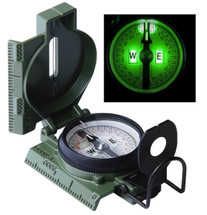Posted by Case Smien on 12th Jun 2023
Tritium Compasses vs. Regular Phosphorescent Compasses: A Comparative Guide
When it comes to navigation tools, compasses are an essential piece of equipment. Traditionally, compasses have utilized phosphorescent materials to provide visibility in low-light conditions. However, in recent years, tritium compasses have gained popularity for their distinct advantages. In this blog post, we will compare tritium compasses to regular phosphorescent compasses, highlighting their features, benefits, and considerations for choosing the right compass for your needs.
1. Illumination:
Regular phosphorescent compasses rely on absorbing light and slowly releasing it, making them glow in the dark. While this can provide visibility for a limited period, the intensity fades over time. Tritium compasses, on the other hand, use tritium gas sealed in a glass tube to emit a continuous, self-powered light source. The tritium glow remains constant without requiring external light sources or recharging.
2. Longevity:
Phosphorescent materials in regular compasses have a limited lifespan and may need periodic exposure to light for recharging. In contrast, tritium compasses have a longer lifespan, typically lasting up to 10-15 years without the need for maintenance or recharging. This long-lasting glow makes tritium compasses ideal for extended outdoor adventures or emergency situations.
3. Visibility in Various Conditions:
Regular phosphorescent compasses offer satisfactory visibility in moderate low-light conditions. However, they may struggle to provide sufficient illumination in extremely dark environments or during nighttime navigation. Tritium compasses, with their constant glow, offer reliable visibility even in complete darkness, making them particularly useful for nocturnal operations or when working in underground or enclosed spaces.
4. Safety Considerations:
Phosphorescent materials are generally considered safe for regular use. However, they may contain chemicals that can be harmful if ingested or inhaled. Tritium compasses, on the other hand, use tritium gas, a low-energy radioactive isotope. While tritium poses minimal risk when enclosed in the glass tube of a compass, it is essential to handle broken tritium devices with caution and dispose of them properly.
5. Legal and Regulatory Considerations:
The use and ownership of tritium compasses may be subject to specific regulations and restrictions in certain jurisdictions due to the radioactive nature of tritium. It is crucial to familiarize yourself with local laws and guidelines before purchasing or traveling with a tritium compass. Regular phosphorescent compasses, being non-radioactive, do not have these restrictions.
Conclusion:
Both tritium compasses and regular phosphorescent compasses have their merits and considerations. Tritium compasses offer continuous illumination, longevity, and visibility in low-light and dark conditions, making them reliable tools for professionals, adventurers, and those in need of a self-powered light source. However, it's important to be aware of safety precautions and legal requirements associated with tritium devices. Regular phosphorescent compasses, while lacking the continuous glow, can still serve well in moderate low-light scenarios and are generally free from regulatory restrictions. Choose the compass that best suits your specific needs and circumstances, ensuring you have a reliable navigation tool for your outdoor journeys.
The US government issues both options for our troops and you can find them on our website using these links:
1. Tritium:
https://militarydepotusa.com/cammenga-us-issue-tri...
2. Phosphorescent:
https://militarydepotusa.com/cammenga-military-pho...
Both are US Made.

